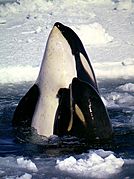Spyhopping facts for kids
Have you ever seen a whale or a shark pop its head out of the water to look around? This cool behavior is called spyhopping. It's when a marine animal rises vertically, holding its body partly out of the water. Imagine a human treading water, but much bigger! They often show their whole head and snout.
Spyhopping is a slow and controlled movement. It can last for several minutes if the animal is really curious about something. Whales usually don't use their tails to stay up. Instead, they use their amazing ability to control how much they float. They also use their pectoral fins (side fins) to keep their position. Their eyes are usually just above or below the water's surface. This lets them see what's happening nearby. Besides whales, big sharks like the great white shark and oceanic whitetip shark also spyhop!
Why Do Animals Spyhop?
Animals spyhop for different reasons. It's a way for them to check out their surroundings above the water.
Looking at Boats
Sometimes, whales spyhop when they are near boats. This often happens during "mugging" situations. This is when a whale focuses on a boat, like those used for whale-watching tours. They might even swim closer and interact with the boat. It's like they are saying hello and getting a better look at the people on board!
Hunting for Food
For orcas (also known as killer whales), spyhopping can be about hunting. Orcas are often seen spyhopping around large pieces of ice called ice floes. They do this to see if prey, like seals, are resting on the ice. If an orca spots a seal, it might spyhop from different spots around the ice. Then, it might make sounds to tell other orcas in its group to do the same. This could be a way to get ready for an attack. Spyhopping is very useful here because it gives them a steady view for a longer time. This is better than breaching, where they jump out of the water. When cetaceans (whales and dolphins) breach, their eyes often don't clear the water. This suggests breaching might be more for hearing than seeing.
Listening for Sounds
Gray whales also spyhop, but often to hear better. They do this when they are near the line where ocean waves start to break. This area is important because it marks their migration route. By spyhopping, they can listen more clearly to the sounds of the ocean. This helps them navigate their long journeys.
So, spyhopping is a very useful behavior. Different animals use it for many different reasons, whether it's to see, hunt, or listen!




